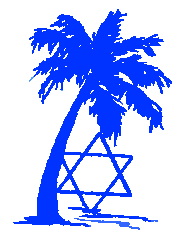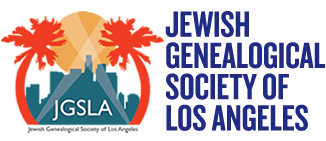May 2006
 |
JGSLA DATES AND UPDATESJEWISH GENEALOGICAL SOCIETY of LOS ANGELES May 2006 |
|
• Program for Monday, May 15, 2006 • |
|
|
7:00 p.m: Charting one’s family history can be a daunting project. An important first step is tracing your ancestors’ journeys to the United States and discovering facts about their early years in America. In April 2001 the Ellis Island website containing passenger records from 1892 – 1923 went online. A few weeks later Stephen P. Morse created the “One-Step Ellis Island” search engine to facilitate using this resource to locate passenger manifests. But what happened when your ancestors disembarked in New York City? A large percentage ended up living there, even if they eventually moved on to other cities or states. Along with the federal census records taken at ten year intervals, there were also several New York state censuses—the most valuable, for genealogical purposes, being those from 1905, 1915, and 1925 when there was a large influx of immigrants. Morse’s One-Step website offers a universal finding aid for searching in each of the three census years in all boroughs. This two-part lecture will explain how to use these tools to navigate both the Ellis Island and New York Census records with fewer tears and greater success so you can track down your elusive ancestors and continue building your family tree. Speaker Stephen P. Morse: Stephen P. Morse is an amateur genealogist who has been researching his Russian-Jewish origins for the past few years. Several years ago he developed some web-based searching aids that, to his surprise, have attracted attention worldwide. He was the recipient of the IAJGS Outstanding Contribution Award in 2003. In his other life Morse is a computer professional with a doctorate degree from New York University. He has held research positions at Bell Labs, IBM Watson Research, GE Corporate R&D, and Compagnie Internationale pour l’Informatique in France. He has been involved in development at Intel Corp, Alsys Inc, and Netscape. He has taught at CCNY, Pratt Institute, UC Berkeley, SUNY Albany, Stanford University, and San Francisco State. He has authored numerous technical papers, written four textbooks, and holds three patents. He is best known as the architect of the Intel 8086, the granddaddy of today’s pentium processor. Location: Skirball Cultural Center, Magnin Auditorium, 2701 N. Sepulveda Duration: This two-part presentation is planned to run until 9:30 p.m. Please plan accordingly. The JGSLA Traveling Spiszman Library of reference books will be available for use starting at 6:30 pm in the Magnin Auditorium. JGSLA members will be available to assist with use of the Library. Snacks: The Skirball Food Cart, with salads and sandwiches, will be available for those people who want to arrive early and purchase a light bite to eat. Attendance Fees: There is no fee for attending this presentation and parking is free. This program is co-sponsored by the Skirball Cultural Center. |
|
| Creative searching of the 1930 Census Joel Schwartz [dr.joelschwartz@sbcglobal.net]One way people “go missing” in the census is when their surnames are transcribed incorrectly. Try searching through Ancestry.com simply by the given name of a child and the given names of each of his or her parents. Passenger Lists, Toronto-Europe, 1911-1917 (Rotenberg Ledger) The JGS of Canada (Toronto) has provided a very valuable new resource for Jewish genealogists with roots in Toronto. The Rotenberg Ledger provides passenger information of people, many of Jewish origin, traveling between Europe and Toronto between 1911 and 1917. The information available includes: names of purchaser and passenger(s), ages of children, points of embarkation and debarkation, passenger line, Toronto address, cost of voyage etc. Previously, access was only available by going to the Jewish Archives in Toronto. Members of JGS of Canada (Toronto) photographed over 800 pages and entered the index of names into a spreadsheet which is available online at their website: [www.jgstoronto.ca/Rotenberg.html] (from JewishGen) Cemetery Project Off to a Good Start JGSLA members met at Beth Israel cemetery in East L.A. on April 2nd to catalog the burials there. This cemetery is in excellent condition with many interesting gravestones. Work will continue on April 23rd and 30th and some members will go out on weekdays. The project needs photographers with digital cameras, Hebrew readers who can translate the Hebrew names on the stones, members who can walk the cemetery and note the information on the stones, and after the cataloging is finished, members to enter the handwritten data into Excel spreadsheets. If you would like to participate, please contact Nancy Holden [holden@interserv.com] or leave a message on the JGSLA voice mail 818/771-5554 Wikipedia |
Finding “Lost” Relatives in the US Census Sally Goodman [sbgoody@usa.net]By accident I found a “lost” relative on a US Census by using “Miss” as a first name. Bingo! There she was. Using every fee-based and non fee-based genealogical search engines I know (including Steve Morse’s One Step), I experimented entering “Miss” as a given name and “Smith” as the surname. I was astounded at the number of results produced. Now I will tackle all my less popular names. If you know the given name, you might try entering “Miss+the first initial” or “Miss+ the given name” in the “First Name” box. Also, try “Mr” and “Dr.” Perhaps you, too, will find your “missing” relatives. Good luck.Common Interest Group Leaders Needed Sonia Hoffman [president@jgsla.org] Sharing information with others who share your interests can be productive and could widen the scope of your research. A while back, JGSLA surveyed members as to their areas of interest, and that data can be used to set up cooperative research for various areas, such as Poland, Ukraine, Belarus, Lithuania among other areas, and can also be narrowed down to research in smaller geographic areas (cities, guberniyas, etc.) Our meeting in September will include time for small groups of people with “common interests” to meet. We can offer other opportunities in conjunction with the regular JGSLA meetings, or as separate special group meetings, particularly if a speaker is found with specialized expertise. Please let us know if you would be interested in helping to coordinate a “Common Interest Group” or assist in any other way in such projects. For our meeting next September, for example, this might involve reporting on a SIG meeting held at the NY Conference in August, bringing some books, maps or other materials to share, telling the group about a visit to your shtetl or about a research project you are involved in. For further information and to offer to assist with a particular “Common Interest” group of JGSLA members, please contact Mel Sofian [mel@jgsla.org]. Surname Navigator Interested in quickly searching a dozen different sources for occurrences of your surname? Check out the Surname Navigator [www.kuijsten.de/navigator/]. You may just discover another connection to research! |
| So, when will the FHL’s resources be online? Jan Meisels Allen [janmallen@worldnet.att.net]Recent news from the Church of the Latter Day Saints indicates that new advances in scanning software and procedures will greatly add to the availability of digital images and indexes of millions of rolls of microfilm stored in their vast underground vaults. The project is estimated to be complete within thirty years, rather than the previous estimated time frame of 120 years. It is expected that in as little as 10 years, much of this vast genealogical collection will be available online. For more on this go to: [www.lds.org/library/display/ 0,4945,40-1-3384-9,00.html].Inexpensive access to Ancestry.com Hal Bookbinder [hal@jgsla.org] As you are surely aware, some libraries (including UCLA and the FHC) subscribe to Ancestry.com allowing you to access this resource free from their facilities. Some versions of Family Tree Maker (FTM), which is owned by Ancestry.com, include free, limited-time subscriptions to Ancestry.com. Last year, I purchased a version of FTM that included a one-year subscription to Ancestry.com. At the time, FTM was being offered with a substantial rebate that made it nearly free. Watch those Fry’s ads! And, there is one Jewish Afghani Ever wonder how many Jews can be found in the various countries around the world? Check out the Jewish Virtual Library [www.jewishvirtuallibrary.org] for this and many more fascinating factoids. According to the Jewish Virtual Library, countries with an estimated Jewish population of over 100,000 in 2003 were: United States (5,914,682), Israel (5,021,506), Russia (717,101), France (606,561), Argentina (395,379), Canada (393,660), United Kingdom (302,207), Ukraine (142,276) and Germany (107,160). As a percentage of population, countries with more than 0.5% Jews include: Israel (80%), United States (2%), Canada (1.2%), France (1%), Argentina (1%), Uruguay (0.9%), Belarus (0.7%), Moldova (0.7%), Hungary (0.6%), Russia (0.5%), United Kingdom (0.5%) and Belgium (0.5%). Missouri Death Index The state of Missouri announced a freely searchable death certificate database containing information on two million death certificates searchable by name, county, or month and year. The database now covers 1910-1920, but will eventually cover 1910-1955. |
Member News We extend our condolences to Ellen Harris on the death of her husband, Clifford, on April 7, 2006. Donations in his memory can be made to the weSPARK Cancer Support Center, 818-906-3022 or [www.wespark.org]We also extend our condolences to David Einseidler, JGSLA Rabbinics maven on the recent passing of his wife, Rose. Our best wishes to Adrian & Sonny Harris on the birth of their fifth grandchild, Angelique (Angie), to Lucie and Glenn Harris on Feb. 16, 2006. Safe Computing – Phishing We have all gotten those emails letting us know that the powers that be are about to suspend our Bank of America, Citibank, Wells Fargo or PayPal account and asking that we click on the link to resolve the situation. When you click on the link, it takes you to what appears to be an official page from the institution. You are then asked to enter some information to identify yourself, including your Name, ID and password. Gotcha! You have just been phished. The page you were taken to, no matter how real it looked, was a phony, simply there to get your personal information to be used to empty your account, for use in identity theft, or otherwise for no good. Don’t click on such a link, and if you do, don’t ever provide information about yourself and your account. If you think it might just be legitimate (and trust me, it never is), then call the institution to check with them. Reputable institutions will never ask you to do this. Don’t Overlook Bookstores for Images A recent Ancestry “Quick Tip” suggested checking out bookstores for community picture books. Alan Simon pointed this out with the following comment, “The reason that it hit a chord with me is that recently I purchased one of Arcadia’s books titled ‘Los Angeles’s Boyle Heights’ published by the Japanese American National Museum. It has some nice photos of early Boyle Heights. But what really made my day is that there was a photo of a group of school children getting off a bus at the Eastside Jewish Community Center (page 85). Scanning the faces in the crowd I spotted two of my cousins as youngsters. What a thrill. You never know what you will find in of these books giving a photo history of a given town.” Share Your Hints and News Please let us know of major family events, brief research stories, exciting research successes and research hints so that they can be shared in Dates & Updates. Send your input to Hal Bookbinder, Dates & Updates Editor, at hal@jgsla.org. |
